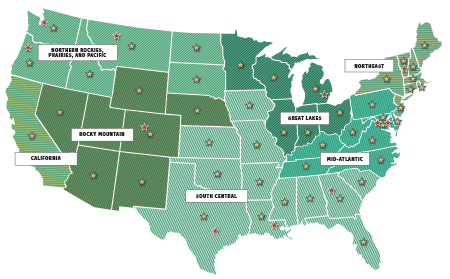More than 185 aquatic invasive species have entered the Great Lakes, including zebra mussels and quagga mussels. The invasive species disrupt the food chain, foul beaches and damage infrastructure—costing citizens, industry and businesses at least $200 million per year. Most of these species were transported into the Great Lakes in the ballast water tanks of ocean-going ships.
Invasive species are one of the worst problems facing the Great Lakes. Effective controls on invasive species are necessary to protect the future of Great Lakes wildlife, recreation, fisheries, and economy.
Ocean-going shipping is the No. 1 source of non-native aquatic species entering the Great Lakes. A new non-native species is discovered on average once every 28 weeks.
Since the St. Lawrence Seaway connecting the Great Lakes to the Atlantic Ocean was opened in 1959, 85 invaders have been discovered and 54 are linked to ballast water discharge. A few invasive species, including the Asian carp, are transported in methods other than ballast water.
Non-native organisms can remain in the crevices of the ballast tank and in the layers of sediment in the bottom of ballast tanks.
Since 1993, ocean going ships have been required to replace their ballast water with ocean water before entering the Great Lakes. This process is known as ballast water exchange. Unfortunately, it does not fully eliminate non-native organisms from ships' ballast tanks.
Though many freshwater organisms cannot survive in salty ocean water, others can survive in both fresh and ocean water. When ballast tanks empty most of their freshwater at sea and bring in ocean water, some species are able to survive in the new moderately salty ballast water.
The National Wildlife Federation is engaged on multiple fronts to protect the Great Lakes from invasive species. We are working for more effective invasive species regulation by the Environmental Protection Agency; stronger water quality and invasive species programs in Great Lakes states; and strong federal legislation that protects the Great Lakes permanently.
Golden Mussel (Limnoperna fortunei)—The golden mussel can inhabit both temperate and subtropical climates, making it likely capable of colonizing waters of the lower Great Lakes region. Once the golden mussel has entered a body of water, it basally attaches itself to most available substrates, and often forms colonies with densities greater than 80,000 per square meter.
Monkey Goby (Neogobius fluviatilis)—Gobies can easily adapt to a wide range of salinities, as exhibited by broad distribution in habitats throughout both the inland freshwater areas and the saline waters of the Ponto-Caspian region. Gobies are able to feed in complete darkness, giving them an advantage over other fish in the same habitat.
Killer Shrimp (Dikerogammarus villosus)—D. villosus has recently invaded and spread throughout Western Europe. Its aggressive behavior causes the replacement of indigenous amphipods, along with changes in the composition of invaded community food webs.
Take the Clean Earth Challenge and help make the planet a happier, healthier place.
Learn MoreA groundbreaking bipartisan bill aims to address the looming wildlife crisis before it's too late, while creating sorely needed jobs.
Read MoreMore than one-third of U.S. fish and wildlife species are at risk of extinction in the coming decades. We're on the ground in seven regions across the country, collaborating with 52 state and territory affiliates to reverse the crisis and ensure wildlife thrive.
